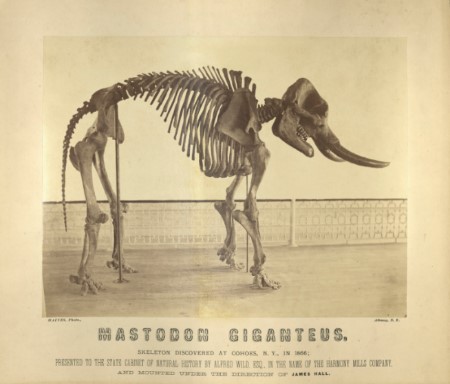James Hall, Jr. (1811-1898) [Section 18 Lot 93]
Father of modern geology, Founder of the New York State Museum, Founder of American Association of Geologists, Founder of International Congress of Geologists, First president of Rensselaer Association of Graduates (Alumni Association), First state Paleontologist

James Hall was born on September 12, 1811, in Hingham, MA, a coastal city south of Boston. The oldest of four children, he was the son of James Hall, Sr., a superintendent of a woolen mill, and Sousanna Dourdain. In his youth, James took a fascination with nature and collected seashells. Advancing in educational pursuits, he enrolled in the newly founded, Rensselaer School in Troy, today’s Rensselaer Polytechnic Institute. Their approach to learning was through what is now known as a modern scientific prospectus, which included field trips and “hands-on laboratory.” Unable to afford the cost of transportation to RPI, he walked the 200 miles from Hingham to Troy.
James studied under Amos Eaton, a geologist, botanist, and a co-founder of the college, as well as Ebenezer Emmons, a geologist who was responsible for naming the Adirondack Mountains and Mt. Marcy. James graduated in 1832 with honors, and he received his master’s degree the following year. James stayed on and worked to teach chemistry, natural science, and geology. In 1836, he worked for the New York State as assistant geologist, working under Emmons in the Second District of northern New York, primarily studying the Adirondacks especially their iron deposits. In 1837, he was assigned to manage the newly created Fourth District, which led him to become the state’s first paleontologist.Geology of New York, Part IV (1843) is the final report on the survey, receiving a lot of acclaim and has become a classic in geological literature.

In 1838 he married Sarah Aiken, a Catholic and daughter of a local lawyer. She was a writer, primarily in the Romantic style, and went on to publish Phantasia and other poems, which include a translation of Friedrich Schiller’s symphonic poem, Ritter Toggenburg. The two had had four children together, two sons, and two daughters. James and Sarah resided at 1 Morton Avenue in Albany, the current location of Albany City Criminal Court. Due to “domestic infidelities” he constructed a separate home for her on the other side of his garden where she had a staff of her own and would visit her on Sundays.
In 1852, a large tract of land on what is today, the southwest corner of Lincoln Park was the site for his laboratory. It was in this laboratory where James discovered the stromatolite fossils of the Petrified Sea Gardens outside of Saratoga Springs. Built by Calvert Vaux and Andrew Jackson Downing, it is one of the last joint projects before his death Downing’s death the same year. It remains one of the few remaining structures of their partnership and listed on the U.S. National Register of Historic Places and a U.S. National Historic Landmark. The structure was converted into a meeting space once the property became a park, and was part of the Sunshine School.

James took on numerous apprentices such as Charles Doolittle Walcott who went on to work at the Smithsonian, and Josiah Whitney, who became a professor at Harvard and created the California Geological Survey. His lab was filled from items from many different collections and was known to “borrow” items for scientific research in the hopes that “the owner might be generously moved or might forget.”
He was active in many geology organizations such as The Geological Society of America where he served at their first president; International Geologic Congress (vice-president); National Academy of Sciences (founding member); the French Academy of Sciences; and Geological Society of London where he received the Wollaston Medal. During the 1850s James continued his work outside of the state where he identified the first fossil reefs in North America while surveying northern Michigan and Wisconsin. James went on to serve as state geologist for Wisconsin and Iowa.
In 1866 he was named the director of the New York State Museum of Natural History, currently the site of the New York State Department of Education. The same year his expertise was needed during the construction of Harmony Mill No. 3 at Cohoes Falls on the Mohawk River. During construction, the remains of a mastodon was discovered in two potholes “which has been worn into the bedrock by the swirling action of water and stones at the end of the last Ice Age.” Known as the Cohoes Mastodon, it went on be on display at the mill, later in Troy, and then a county fair before it was gifted to the state the following year. The Cohoes Mastodon is on permanent exhibition in the lobby of the New York State Museum.
James published numerous bodies of work during his lifetime. From 1847 – 1894 he published 13 volumes of The Paleontology of New York, over 30 books, and assisted in federal and state publications as well as over 1000 works. His wife illustrated many of James’ work.
James died in 1898 in Bethlehem, New Hampshire and is buried in the Hall family plot. Today one of the residence halls is named in his honor at RPI, Hall Hall.